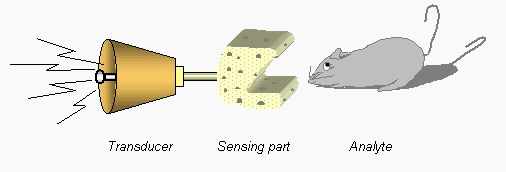KJ8056: Kjemiske og biologiske sensorer / Chemical Sensors and Biosensors
This subject is tought at Norwegian University of Science and Technology (NTNU), Department of Chemistry, NO-7491 Trondheim, NORWAY
Course Details
Lectures: Fall semester, 2 hours
a week. Teaching language: English. Oral examination. Credits: 7.5 ECTS.
Course Lecturer
Florinel
Gabriel BANICA
Tel.: +(47) 73 59 69 57
E-mail:
F.Banica(a)chem.ntnu.no
Office: Realfagbygget, Room D2-127
SITE CONTENTS
- A short presentation of the topic
- Pensum/Syllabus
- Reading Material
- Periodicals
- Web sites dedicated to Chemical Sensors
A chemical sensor is a self contained probe that provides in real time information about the chemical composition of its surroundings.
An example: the glass electrode is able to recognize the hydrogen ion by selective ion exchange and gives rise to a membrane electric potential that is a function of hydrogen ion concentration.
What a chemical sensor looks like?

- Substitution of standard analytical procedures by fast detection and analysis using dedicated sensors;
- Automation of the analysis and monitoring of chemical quantities;
- Field analysis by means of portable instruments
- Industry: process analytical chemistry;
- Environment: automatic monitoring of chemical pollution
- Biomedical Science: fast and/or in vivo monitoring of drugs and biologically important compounds (e.g. O2, CO2 and glucose content in blood)
- Food industry and Biotechnology: automatic control of chemical parameters,such as pH, O2 and CO2 content, or nutrient concentration.
|
An application:
Measuring pH in meat
Measuring pH in slaughtered meat is
a good way to monitor product quality. A lance-shaped ISFET probe
(Sentron), with a large handle for good grip, is an ideal solution
for fast, accurate and most of all, safe measurements. More>> |
|
Main sections
Electrochemical sensors
Biosensing - General Aspects
Fiber-Optic Chemical Sensors
Microgravimetric Sensors and Acoustic
Devices
Solid-state Gas Sensors
- Florinel-Gabriel Banica, Chemical Sensors and Biosensors: Fundamentals and Applications, John Wiley and Sons, 2012.
- D. Diamond (Ed.), Principles of chemical and biological sensors, Wiley, New York, 1998..
Available at
http://www.amazon.com/gp/search?index=books&linkCode=qs&keywords=0470710667
http://eu.wiley.com/WileyCDA/WileyTitle/productCd-0470710667,descCd-tableOfContents.html
Other relevant texts
Papers on chemical and biological
sensors are regularly published in all the major Analytical Chemistry journals.
The following journals are dedicate exclusively to this topic:
Sensors
and Actuators. B, Chemical (Elsevier Science)
Biosensors
and Bioelectronics (Elsevier Science)
IEE
Sensors Journal
Sensor
Letters (American Scientific Publishers)
Sensors
(A free, on line journal)
Sensors
Update (Wiley)
Potentiometric sensors
Amperometric Sensors
Semiconductors-Field Effect Devices
Fiber Optics Sensors
Biosensors
Mass-sensitive sensors (Piezoelectric devices)
Gas sensors
Electronic nose / Electronic tongue
Varia
Last update : August 14, 2009
Copyright © 2005 by Florinel
Gabriel Banica